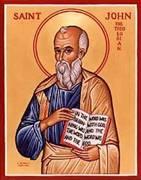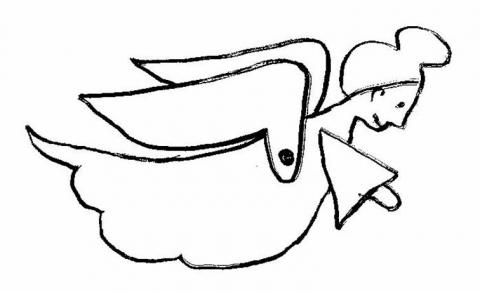St. John and The Revelation
JOHN/REVELATION
Objectives:
 Students should be able to identify the apostle John.
Students should be able to identify the apostle John.- Students should be able to identify the Book of the Revelation as John’s writing.
- Students should be able to identify the Second Coming.
Suggested Lesson Plan:
- Open with prayer.
- Read the the Beginner’s Bible 504-508 or the CBR 292-295. The Golden Children’s Bible has a short section on John on pages 509-510 and the Read with Me Bible on pages 436-437. Supplement with the following story; have ready the icons of the Transfiguration, Crucifixion, Ascension, and Pentecost to identify John in each (and break up the story):
A very, very old man sat alone in the hot sun. It was Sunday and the man was praying. Suddenly the silence of the deserted island was split by a loud voice like the sound of a trumpet, telling the old man, “Write in a book what you see, and send it to the seven churches.” The man turned to see who was speaking to him and saw the Lord Jesus in all His glory, risen and surrounded by angels. Jesus gave the man messages for the churches. Then He showed the man the glory of the heavenly kingdom, with the heavenly creatures and angels and risen Christians worshipping the Lord forever and ever. The man saw a vision of the end of all the earth and the victory of the Lord over all His enemies, a mighty and fearful vision. The man wrote down all he had seen, just as the Lord had commanded.
Who was this old man? His name was John, one of the twelve apostles who had known Jesus and traveled with Him in the land of Galilee. John had been a young man when Jesus had called him and his brother James while they were mending their fishing nets. The two brothers, sons of Zebedee, had followed Jesus and listened to His teachings and watched His many miracles. John had seen the Lord Jesus revealed in power at the Transfiguration. He had seen the raising of Jairus’s daughter and later of Lazarus from the dead. He had helped Peter prepare the Last Supper. He had been with the Lord as Jesus prayed in the Garden of Gethsemane. He had seen the Lord taken by the soldiers and condemned to die on the cross. John had been the onlyu one of the disciples to stand at the foot of the cross with Jesus’s mother Mary and the other faithful women. Jesus had looked down from the cross and told John to care for His mother, and John took Mary into his own home from that day. When Mary Magdalene ran to the frightened and hiding disciples to tell them the Lord was risen, John and Peter had run to the tomb to see for themselves. After the Resurrection, John had seen and talked with Jesus many times until Jesus ascended into heaven. All of these things – the life and death and Resurrection of Jesus that John had seen and heard with his own eyes and ears – he wrote down for all of us in the book we now call the “Gospel of John”.
After the Resurrection, John was one of the leaders of the early Church. He helped Peter and James in guiding the church in Jerusalem. Then, John traveled to Asia Minor and settled in the city of Ephesus. From Ephesus he led the church in Asia. John was known for the loving concern he had for his brothers and sisters. A story is told that, while traveling in a certain city, John saw a young man and entrusted him to the bishop of the city to teach him about the Lord. But, when John came back to the city, he was told that the young man had made bad friends and had become a robber. This made John very sad, and he went into the mountains where the robbers lived. He was captured by the robbers and found the young man and told him that Jesus still loved him. The young man then cried and said that he was sorry for his evil way of life and went back to the church. So, the apostle John cared for his churches with love and charity.
When John was already an old man, loved by Christians everywhere, he was the only one of the twelve still alive. When the Emperor Domitian, a cruel and wicked ruler, came to the throne, he ordered John captured by the soldiers and brought to the Emperor in Rome. There, he tried to kill John in a pot of boiling oil, but John was not hurt at all. (Remember the story of the three men in the fiery furnace?) Since he could not kill the apostle, the emperor sent him to the deserted island of Patmos. There John had the great vision of the Lord and wrote the book we now call “The Revelation” in the Bible.
Finally, Domitian died and John was able to go back to Ephesus. From there he wrote three letters, which we now have in our Bible as the “Epistles of St. John”. As an old man, John told the people over and over to love each other. John died peacefully in Ephesus and joined the Lord he had loved so well.
Add St. John to your timeline.
- Feed the Elephant True/False Questions:
True False
John was a fisherman. John was a carpenter.
John took Mary into his home. John was too scared to come to the cross.
John had a vision on the island of Patmos. John was killed by boiling in oil.
John died peacefully as an old man. John was known for his hatred.
- The Book of the Revelation is much to complex and the subject of too much theological controversy to approach with this age group. But – all children have dreams. Let them discuss their dreams. What is the difference between a dream and a vision? There are many instances of dreams and visions in the Old Testament that we already have studied – the dreams of Pharaoh, the dreams of the butler and the baker, the vision of Samuel, the visions of the prophets (e.g. Ezekiel and the bones). And in the gospels, Joseph had two life-changing dreams – when God told him to marry the Theotokos and when the angel told him to escape from Bethlehem to Egypt. Review these stories – look at the pictures in their Read with Me Bibles. God can speak to us in both visions and dreams. John’s vision was full of angels and trumpets – an end-time parade. March around the room being angels playing your trumpets for the Lord Jesus.
- What is an angel? Ask to children to describe as they understand angels. Angels are God’s attendants and messengers. The Orthodox Church teaches that there are 9 “choirs” of angels: angels, archangels, powers, authorities, principalities, dominions, thrones, cherubim and seraphim. Do the students remember any of these mentioned in our liturgy? Angels are invisible (most of the time; can you think of an exception? The Annunciation!), of tremendous power and strength. They don’t have bodies as we know them. Try to fill these blanks with either “people” or “angels” or “angels and people”:
_______________ were created by God. _________are always young.
_______________have bodies. _________think and do things.
_______________never die. _________need to eat and drink.
_______________have names.
- Make an angel (or several for a mobile):
Cut an angel shape from white construction paper (or a paper doily). Color hair and draw eyes and mouth. Cut wings; decorate wings with feathers if desired. Attach wings with a brad. Use gold glitter for halo and trimmings on gown. If you want, make several and hang at different heights from a hanger for a mobile.
- Close with prayer: Lord, let me see You this week all around me in my dreams and in your invisible helpers, the angels.
